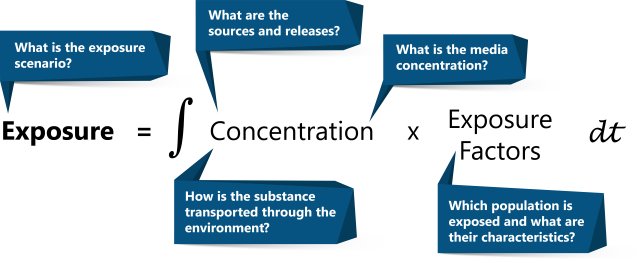Exposure Calculations
Overview
Exposure assessment is the process of estimating or measuring the magnitude, frequency and duration of exposure to an agent and the size and characteristics of the exposed population.
A common approach for quantifying exposure for risk assessment is to combine the use of environmental monitoring data with model outputs. This approach integrates measured concentrations with the effects of fate and transport processes.
Types of Calculations
Depending on the assessment, the measurement or modeling approach can be characterized in multiple ways which are summarized in table 2-3 of the Guidelines for Human Exposure Assessment (2019) and in the table below:
| Visual | Type |
|---|---|
 |
Exposure assessments can range from screening-level to highly refined. See information related to screening-level and refined assessments |
 |
Exposure assessments can use a set of single point values (deterministic) or a distribution or range of point values (probabilistic). See information related to deterministic and probabilistic assessments |
 |
Exposure assessments can assess exposure to multiple agents (aggregate) or multiple pathways (cumulative). See information and tools related to aggregate and cumulative |
Calculations
Exposure is contact between a target organism (like a human or plant) and a pollutant at the outer boundary of that organism.
When a contaminant crosses the outer boundary and is taken into the body via ingestion, inhalation, or through the skin, the amount that gets into the body in a biologically available form is called the dose.
Exposure or dose calculations depend on the intensity, frequency, and duration of contact to an agent or stressor. Exposure magnitude is usually expressed as the concentration of contaminant per unit mass or volume (e.g., μg/g, μg/L, mg/m3, ppm) within the environmental media to which exposure occurs.
Dose The amount of a substance available for interactions with metabolic processes or biologically significant receptors after crossing the outer boundary of an organism. refers to the amount of an agent that enters a receptor after crossing an external exposure surface. Exposure assessors can calculate multiple types of dose, including:
- Applied Dose is the amount of agent at an absorption barrier Any exposure surface that may retard the rate of penetration of an agent into a target. Examples include the skin, respiratory tract lining, and gastrointestinal tract wall.
- Biologically Effective Dose is the amount of agent that reaches the target internal organ, tissue or toxicity pathway where the adverse event occurs
- Delivered Dose is the amount of agent transported to the location where the adverse effect occurs
- Absorbed/Internal Dose is the amount of agent that enters a receptor by crossing an exposure surface acting as an absorption barrierabsorption barrier Any exposure surface that may retard the rate of penetration of an agent into a target. Examples include the skin, respiratory tract lining, and gastrointestinal tract wall.
- Potential Dose is the amount of agent that enters a receptor after crossing an exposure surface that is not an absorption barrier

Below is a general equation for calculating the potential dose The amount of contaminant ingested, inhaled, or applied to skin, not all of which is actually absorbed.. See also the relevant information on exposure scenarios/setting, sources and releases, media concentration, exposed population, and exposure factors

This equation will vary based on the exposure route. See equations and methods for assessing exposure based on route.
